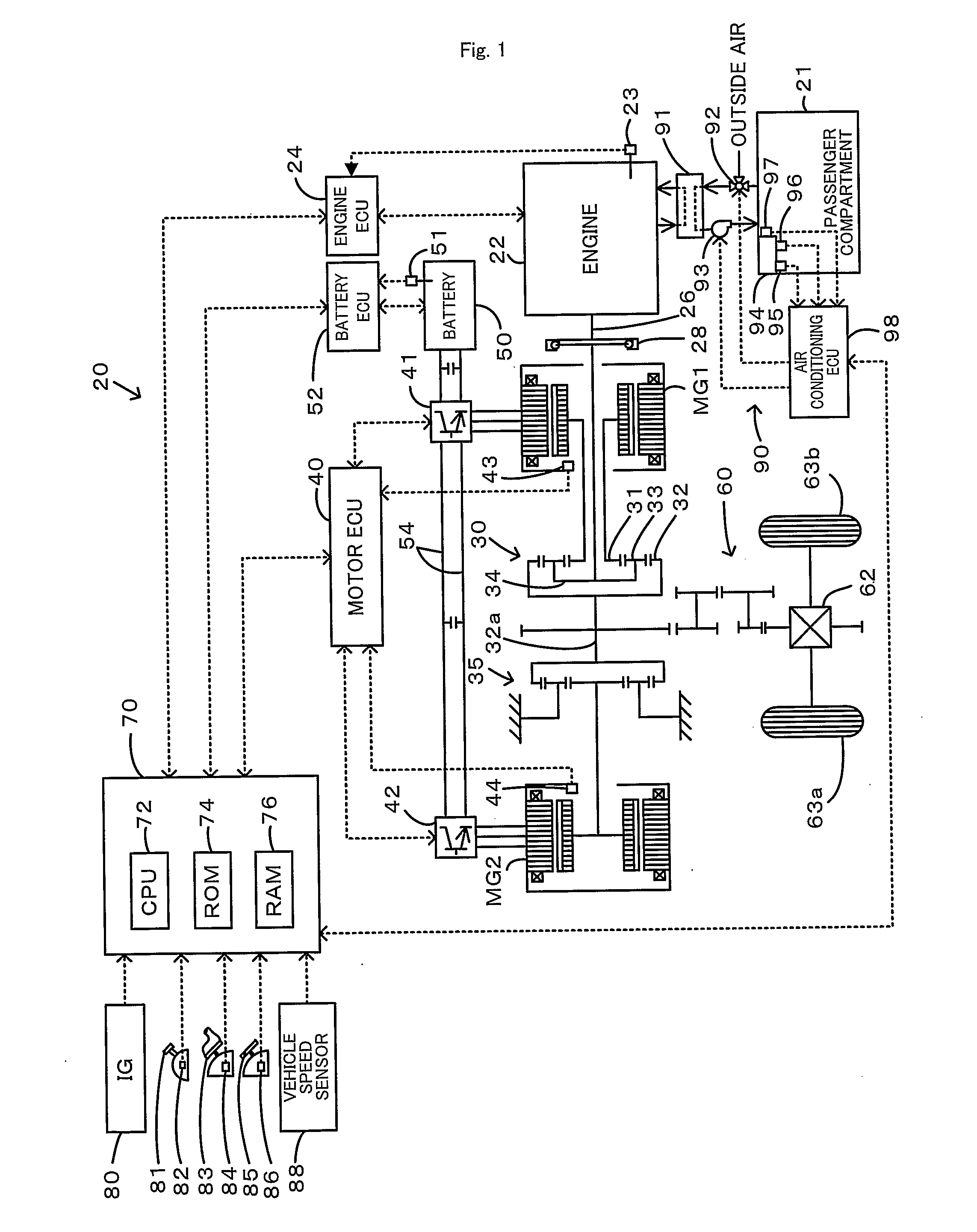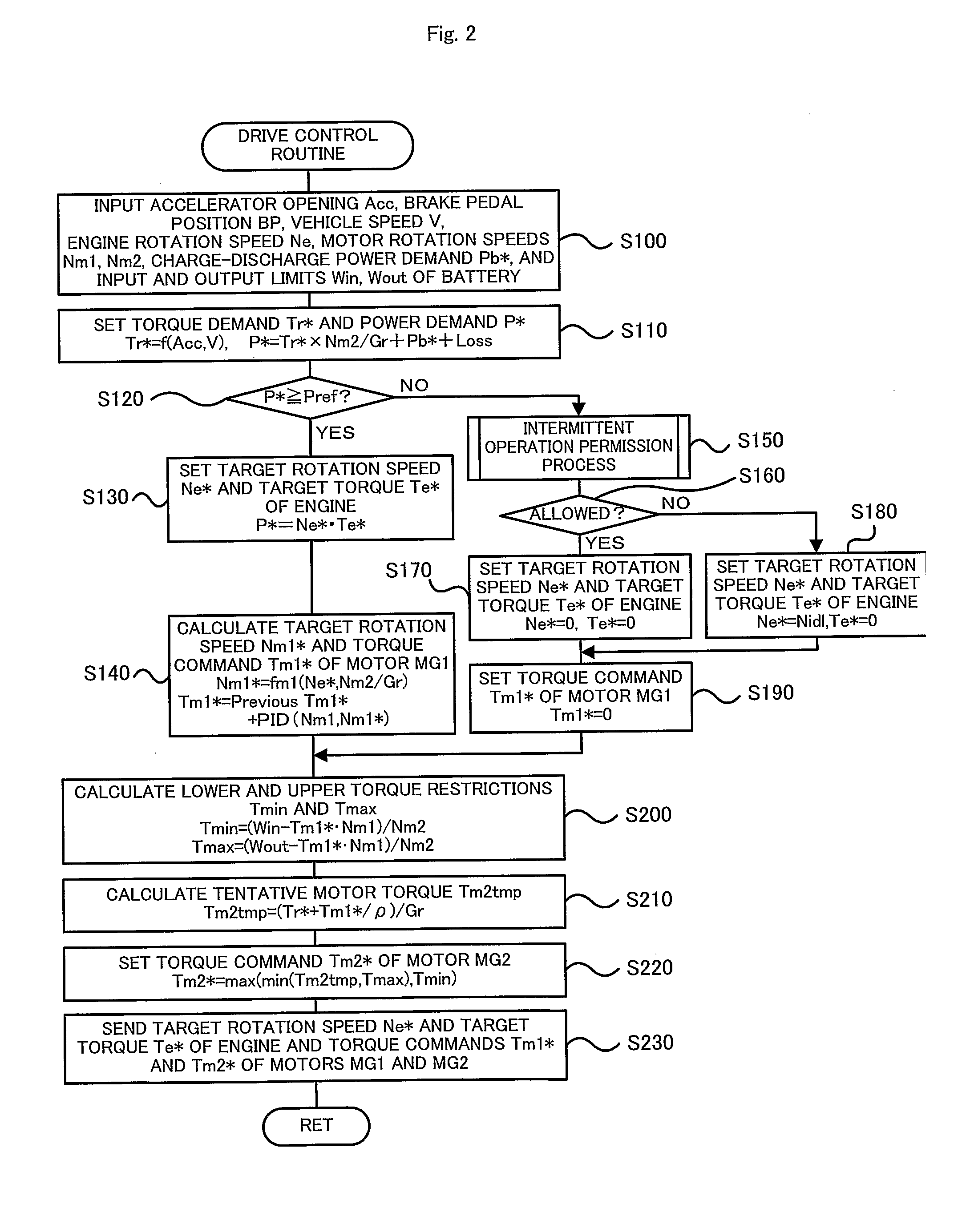[0003] For the purpose of the
environmental protection, preference may be given to the enhanced energy efficiency of the vehicle over the high-level heating performance of the passenger compartment. The permission for the intermittent operation of the engine as the heat source even in a low temperature range for the restricted heating performance sacrifices the comfortable ride of the driver and other passengers, while enhancing the energy efficiency of the vehicle. The prohibition on the intermittent operation of the engine as the heat source for the high-level heating performance, on the other hand, undesirably lowers the energy efficiency of the vehicle, while ensuring the comfortable ride of the driver and other passengers.
[0007] In the first
hybrid vehicle of the invention, in response to no reception of the fuel consumption priority instruction during heating of the passenger compartment, permission for intermittent operation of the
internal combustion engine is given upon condition that the cooling
water temperature of the
internal combustion engine is not lower than the preset first temperature. Otherwise the prohibition is placed on the intermittent operation of the
internal combustion engine. In response to reception of the fuel consumption priority instruction during heating of the passenger compartment, on the other hand, permission for the intermittent operation of the internal
combustion engine is given upon condition that the cooling
water temperature of the internal
combustion engine is not lower than the preset second temperature, which is below the preset first temperature. Otherwise the prohibition is placed on the intermittent operation of the internal
combustion engine. In response to the permission for the intermittent operation of the internal combustion engine, the internal combustion engine and the motor are controlled to ensure the output
power level corresponding to the
power demand to the
drive shaft with the intermittent operation of the internal combustion engine. In response to the prohibition on the intermittent operation of the internal combustion engine, on the contrary, the internal combustion engine and the motor are controlled to ensure the output
power level corresponding to the
power demand to the
drive shaft with
continuous operation of the internal combustion engine. The first
hybrid vehicle of the invention thus ensures the output
power level corresponding to the
power demand to the
drive shaft with the intermittent operation of the internal combustion engine even in a lower temperature range of the cooling water of the internal combustion engine in response to reception of the fuel consumption priority instruction during heating of the passenger compartment, compared with the case with no reception of the fuel consumption priority instruction. This arrangement effectively improves the energy efficiency of the vehicle, while ensuring a certain level of heating performance.
[0012] In the second hybrid vehicle of the invention, in response to no reception of the fuel consumption priority instruction during heating of the passenger compartment, permission for intermittent operation of the internal combustion engine is given upon condition that either the temperature of the internal combustion engine or the temperature of a medium, which depends on the temperature of the internal combustion engine, is not lower than the preset first temperature. Otherwise the prohibition is placed on the intermittent operation of the internal combustion engine. In response to reception of the fuel consumption priority instruction during heating of the passenger compartment, on the other hand, permission for the intermittent operation of the internal combustion engine is given upon condition that the control temperature is not lower than the preset second temperature, which is below the preset first temperature. Otherwise the prohibition is placed on the intermittent operation of the internal combustion engine. In response to the permission for the intermittent operation of the internal combustion engine, the internal combustion engine and the motor are controlled to ensure the output power level corresponding to the power demand to the drive shaft with the intermittent operation of the internal combustion engine. In response to the prohibition on the intermittent operation of the internal combustion engine, on the contrary, the internal combustion engine and the motor are controlled to ensure the output power level corresponding to the power demand to the drive shaft with
continuous operation of the internal combustion engine. The second hybrid vehicle of the invention thus ensures the output power level corresponding to the power demand to the drive shaft with the intermittent operation of the internal combustion engine even in a lower temperature range of the cooling water of the internal combustion engine in response to reception of the fuel consumption priority instruction during heating of the passenger compartment, compared with the case with no reception of the fuel consumption priority instruction. This arrangement effectively improves the energy efficiency of the vehicle, while ensuring a certain level of heating performance.
[0014] In the control method of the invention, in response to no reception of the fuel consumption priority instruction during heating of the passenger compartment, permission for intermittent operation of the internal combustion engine is given upon condition that the cooling water temperature of the internal combustion engine is not lower than the preset first temperature. Otherwise the prohibition is placed on the intermittent operation of the internal combustion engine. In response to reception of the fuel consumption priority instruction during heating of the passenger compartment, on the other hand, permission for the intermittent operation of the internal combustion engine is given upon condition that the cooling water temperature of the internal combustion engine is not lower than the preset second temperature, which is below the preset first temperature. Otherwise the prohibition is placed on the intermittent operation of the internal combustion engine. In response to the permission for the intermittent operation of the internal combustion engine, the internal combustion engine and the motor are controlled to ensure the output power level corresponding to the power demand to the drive shaft with the intermittent operation of the internal combustion engine. In response to the prohibition on the intermittent operation of the internal combustion engine, on the contrary, the internal combustion engine and the motor are controlled to ensure the output power level corresponding to the power demand to the drive shaft with
continuous operation of the internal combustion engine. The control method of the invention thus ensures the output power level corresponding to the power demand to the drive shaft with the intermittent operation of the internal combustion engine even in a lower temperature range of the cooling water of the internal combustion engine in response to reception of the fuel consumption priority instruction during heating of the passenger compartment, compared with the case with no reception of the fuel consumption priority instruction. This arrangement effectively improves the energy efficiency of the vehicle, while ensuring a certain level of heating performance. In one preferable embodiment of the control method of the invention, the step (c) gives permission for the intermittent operation of the internal combustion engine, based on a starting-time cooling water temperature measured by the step (b) at a first start of the internal combustion engine since activation of the hybrid vehicle. In this case, the step (c) may give permission for the intermittent operation of the internal combustion engine, based on the preset second temperature, which decreases with an increase in starting-time cooling water temperature.
 Login to View More
Login to View More  Login to View More
Login to View More 


